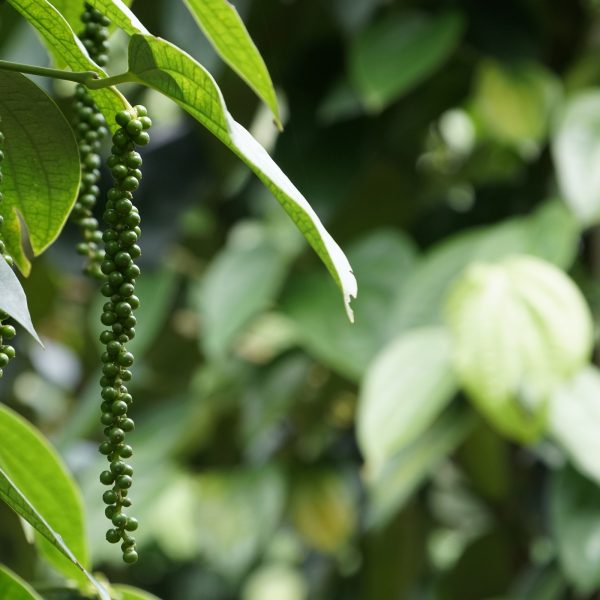-
How does it feel?
Trikatu is a blend of ginger, long pepper and black pepper.
Ginger is a stout and tall green leafy herb with a characteristically tuberous, jointed root. The roots are thick and fleshy with a strong, pungent odour. Ginger is widely cultivated but originates from warm and moist areas of India, China, Sri Lanka and a number of south-east Asian countries.
Long pepper is a slender and aromatic climber. The fruits are small, shiny and blackish green ovid berries that are embedded in fleshy spikes. Long pepper is native to South Asia and throughout the hotter parts of India.
Black pepper is a climbing shrub that can grow to heights of 6metres. The fruits are oblong and bright red when ripe and black once dried. Black pepper is native to tropical parts of India but is also cultivated in Sri Lanka, China and Africa.
-
What can I use it for?
The hot and drying effect of trikatu clears the lungs of mucous membrane congestion and phlegm. It will mobilise, thin and reduce excessive mucous. Trikatu stimulates the circulation and enhances the body’s natural immune response to seasonal infection. The stimulating properties of trikatu will kick-start a slow metabolism and weak digestion back into optimum functioning. Trikatu also increases the secretion of digestive enzymes that improve digestion and absorption within the digestive tract.
-
Into the heart of trikatu

Ginger Ginger is warming and spicy in its nature providing wonderful thermogenic properties that increase the metabolism and increase the secretion of digestive enzymes. Ginger is a traditional remedy for all forms and causes of nausea. Constituents such as gingerols and shogaols stimulate the circulation and increase peripheral warmth helping to ward off the invasion of cold and damp conditions; it also will influence vasodilation and sweating. Ginger is a valuable anti-inflammatory for arthritic conditions and helps to clear congested toxins from the blood stream but also reduce the pain associated with muscular cramping and spasms.
Long pepper stimulates the micro-circulation and contains a constituent known as piperine which enhances the bio-availability and absorbability of a number of herbs and foods, improving nutrition: This has made long pepper a traditional herb for cases of malnutrition. Long pepper has anthelmintic properties that expel parasites and balance the gut flora, ridding the body of bloating and wind. It is particularly helpful for both diarrhoea and constipation. It encourages vasodilation and, therefore, improves the circulation. From an Ayurvedic point of view, long pepper is a specific rejuvenative to the lungs.

Long pepper Black pepper also contains the active constituent, piperine, giving it the ability to increase the absorption of nutrients and phytonutrients from food by improving permeation through the epithelial wall of the small intestine. The hot and penetrating nature of black pepper make it a fantastic digestive stimulant; it also increases the secretion of digestive enzymes and is a good remedy for encouraging a weak appetite. Black pepper is characteristically spicy and will stimulate the microcirculation, helping to clear excess mucous from the digestion but also the lungs, ears, nose and throat. The spicy nature of black pepper has made it effective at clearing stagnant and congested conditions that result in the formation of lumps and cysts.
Trikatu is indicated, where there is low digestive activity with sluggishness, bloating, abdominal pain and flatulence due to kapha or vata. It helps in conditions of poor assimilation due to parasites, leaky gut or low enzyme secretions. Trikatu can help alleviate symptoms of IBS, Candida albanicans and diarrhoea where they are irritated by food intolerances and damp, wet and heavy foods. It is a specific remedy to help burn ‘ama’ and undigested toxins in the digestive tract and blood stream.
As Trikatu rejuvenates the lungs, it is used whenever there is coughing, wheezing and breathing difficulties with clear, sticky and white phlegm. It is used in asthma, bronchitis, pneumonia, cough and colds. Trikatu is a superb remedy for hayfever and acute allergic rhinitis as an immediate way of drying up the copious nasal secretions and possesses anti-allergenic effects due to its histamine reducing response. It is effective for sinus congestion and chronic nasal blockage. Trikatu has an affinity for all the orifices of the head, clearing that muzzy headed feeling and can help clear blocked ears and treat sore throats.
Trikatu can be part of a treatment strategy where there is low metabolism, hypothyroidism and the concurrent increase in weight, low energy, and lowered immunity. Where there is high cholesterol, Trikatu may be indicated to encourage digestion of excess lipids. With any feeling of coldness, Trikatu can help to warm the body.
-
Traditional actions
Herbal actions describe therapeutic changes that occur in the body in response to taking a herb. These actions are used to express how a herb physiologically influences cells, tissues, organs or systems. Clinical observations are traditionally what have defined these actions: an increase in urine output, diuretic; improved wound healing, vulnerary; or a reduction in fever, antipyretic. These descriptors too have become a means to group herbs by their effects on the body — herbs with a nervine action have become the nervines, herbs with a bitter action are the bitters. Recognising herbs as members of these groups provides a preliminary familiarity with their mechanisms from which to then develop an understanding of their affinities and nuance and discern their clinical significance.
-
Traditional energetic actions
Herbal energetics are the descriptions Herbalists have given to plants, mushrooms, lichens, foods, and some minerals based on the direct experience of how they taste, feel, and work in the body. All traditional health systems use these principles to explain how the environment we live in and absorb, impacts our health. Find out more about traditional energetic actions in our article “An introduction to herbal energetics“.
-
Did you know?
Trikatu has been traditionally used in Ayurvedic medicine to enhance the absorption of other herbs in addition to foods.
Additional information
-
Safety
2-3 capsules 2-3x/day or 250-500mg 2-3x/day.



































